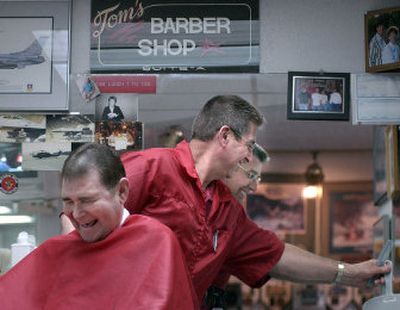Tom’s Barber Shop more than ‘the usual’

Bus driver John Ruscio and barber Tom Groh have been having variations of the same conversation for the past 38 years.
Every couple of weeks, Ruscio’s wife, Ellen, dispatches him to Tom’s Barber Shop on Bowdish Road for a little haircut. She prefers Ruscio’s hair a little longer. Ruscio prefers it short, which makes Groh the King Solomon of combs and shears.
“How mad do you want to make her?” the barber asks, to which Ruscio replies that “the usual” will do just fine.
At month’s end, Groh will have cut hair near the same intersection of Bowdish Road and Sprague Avenue for 40 years. A myriad of other barbers who now compete with him earned their chops in his small, four-chair shop inside a converted stucco house.
“I’ve always gone to Tom,” Ruscio said. “I think his nephew, Irv, did it once. When I was working for the railroad, we moved to Puyallup for nine months. I got two bad haircuts over there and started driving back to Spokane to see Tom. Even if I lived in Seattle, I’d get my haircut here.”
Groh just smiles when the matter of his tenure comes up.
“I just like my job,” said Groh, 59. “I always wanted to cut hair. For all the business I’ve done here, the community has given me so much more.”
Groh’s shop is more than swivel chairs and disinfectant. The décor is sort of doctor’s waiting room meets urban hunting lodge. A dozen nap-worthy, black leather chairs are spread out in a horseshoe formation around an art deco fireplace. The heads of two respectable trophy deer, one downed by Tom Groh, the other by nephew and partner, Irv Groh, are positioned like bookends over the corners of the brick fireplace.
There are reprints of vintage outdoorsman posters framed and hung on the walls of the waiting room. Each print portrays a clean-cut, wool-clad man roughing it with either gun or fishing rod in hand. Perhaps by chance, or shared interest, many of the men waiting for haircuts have coiffures that would fit the outdoorsmen in the reprints just fine.
Tom Groh is a man’s man, said Charles Stocker, who first walked into Groh’s barbershop 35 years ago when Stocker was an administrator for Central Valley School District and worked two blocks down the street.
The barber can talk knowledgeably about everything from local sports lore to backcountry horseback riding and fishing, which isn’t to say he has the gift of gab; men’s men seldom do. Groh holds up his end of a conversation, but never expends a full sentence when a well-placed “yeah” or “uh-huh” will do.
“That’s Tom,” Stocker said. “I would describe him as very thorough, a good, fun-loving person. When I was superintendent of Freeman School District, and Tom lives in that district, if we had bleachers that needed an extra coat of paint, Tom was there to do it. He’d stripe the football field on his day off.”
Groh has done his best to make the barbershop more than a place to get a haircut, which is the kind of shop he grew up around as a kid in Odessa, Wash., a town founded by German immigrant farmers from Odessa, Russia.
In 1950s Odessa there was only one barbershop, a one-chair operation where Del Kirstein cut hair. Frequented by most of the men in the community, the shop was the best place to pick up the local scuttlebutt.
“B.S. doesn’t just stand for barbershop,” Groh said.
The setting at Kirstein’s influenced Groh so much he’d decided in eighth grade that barbering would be his profession. Breaking into the business meant attending barber college in Spokane. The Lilac City has no barber colleges now, but in the 1960s, when Groh learned the trade, Spokane had three schools.
Moler Barber College, where Groh studied, was on a rough stretch of Main Avenue between Washington and Stevens streets, near Dutch’s Pawnshop. He was expected to come to class with his own subject on whom to work. Students who showed up without a model in tow were dispatched to the BBB Beer Parlor and Card Room or the Crossroads Tavern to draft a subject, Groh said. The school would try to get tavern patrons to pay a quarter or two for the trim, but if the subject refused, the haircut was a freebie. Students not only learned the art of a good haircut and shampoo, but also how to give a clean shave, a lesson that’s been largely lost now that most hairstylists earn their licenses at cosmetology schools.
Barber college graduates were required to apprentice for at least a year under an established barber. Groh wound up cutting hair for Ralph Phillips at Crystal Barbershop in Spokane Valley, just down the street from where Groh’s is now.
But it didn’t take Groh long to get his own place going. He opened his shop down the street, installed a pool table and has been cutting the same heads of hair and asking the same questions ever since.
“How mad do you want to make her?” Groh will ask Ruscio.
“Oh, the usual,” the bus driver will reply. Just like always.